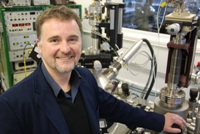Graphene breakthrough

Professor Andrew Evans, Director of IMAPS, is leading the research
07 March 2013
Materials physicists at the Institute of Mathematics and Physics (IMAPS) at Aberystwyth University have discovered a new method for producing graphene, a material with amazing optical and electrical properties.
Graphene is a single layer of carbon atoms bonded together in a similar way to graphite. However, it has very different and superior material properties.
Experiments have shown that graphene is one of the strongest known materials and one of the best conductors of heat and electricity. It is also almost transparent to visible light.
Professor Andrew Evans, Director of IMAPS, who headed up the research team said: “Graphene is many hundreds of times stronger than today’s construction materials and much faster and lighter than electronic materials such as silicon. It is a more sensitive gas detector than any currently available, being able to sense single molecules and it could replace conducting glass in displays and solar cells.
“Graphene will be to the 21st century what plastic and silicon were to the 20th, being a material that can be used in diverse number of ways which will create faster, thinner, more flexible and cheaper devices.
“This latest discovery undertaken at IMAPS reflects the ambition we have as an international centre of excellence and will develop the University’s reputation as a globally-significant centre of research.”
One of the main challenges is to find economic ways of producing large areas of high quality graphene that can then be processed into small, light and efficient devices.
In a paper published in the journal CARBON, post graduate researcher, Simon Cooil, Professor Andrew Evans and their collaborators describe how equipment developed at Aberystwyth has enabled them to grow sheets of graphene by controlling the exchange of carbon from the surface of a diamond into a perfect crystal of graphene.
The diamond is first treated with a few layers of iron that acts as a catalyst and is then heated to initiate the exchange.
They have shown that it is possible to stop the process at a single graphene layer and then carry on to two, three, four and more layers.
Compared with other methods for preparing graphene, this new process offers a lower fabrication temperature and a larger area of crystalline quality.
It also makes the lithography of devices easier since the pattern can be drawn in the metal layer rather than directly in the ephemeral layer of graphene.
Working in collaboration with colleagues at NTNU (Norwegian University of Science and Technology) at Trondheim, Norway and at MaxLab in Lund, Sweden, they have shown that it is also possible to turn silicon carbide into graphene using the same method and the same catalyst, in this case reducing the temperature needed from over 1000C to a more industrially realistic 600C.
The team have now filed an international patent application for this novel method of making graphene.
This research work was funded by the Engineering and Physical Sciences Research Council (EPSRC) and carried out within the Centre for Advanced Functional Materials and Devices, a HEFCW-funded research and enterprise partnership between Aberystwyth and Bangor Universities.
The full paper is available online at http://www.sciencedirect.com/science/article/pii/S0008622312005696.
AU2013



